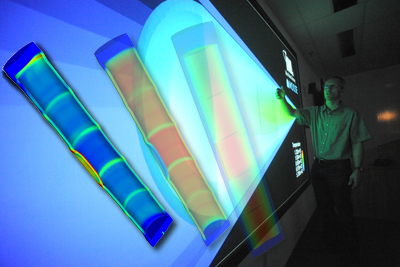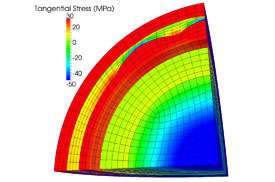BISON enables complex nuclear fuel modeling, simulation

It's rare that a chipped nuclear fuel pellet makes its way into a reactor. But if one of the millions of pencil-sized pellets does have a small defect, it can affect the fuel's performance. How exactly these effects evolve is just one of the situations BISON can simulate in an effort to help engineers enhance nuclear fuel safety margins.
No, BISON is not an animal (though if it were, it would be very smart). BISON is a computer code developed at Idaho National Laboratory. It is one of a herd of applications—most also named after animals—that utilizes the Multiphysics Object Oriented Simulation Environment (MOOSE) framework, also developed at INL.
Creating simulations is a time-consuming task requiring extensive computer science knowledge. BISON makes it easier for researchers to gain insight into processes which they would not otherwise have resources to simulate on their own. The code enables engineers to troubleshoot new ideas before building prototypes or experimental tests. By refining designs based on simulation data, scientists can maximize the efficiency of time and resources dedicated to testing in research reactors.
BISON can simulate a variety of fuel types such as those used in commercial nuclear reactor power plants, plate-type fuel used in some university and research reactors, metallic-type fuel, and TRISO particle fuel used in Very High Temperature Gas Reactors. It can simulate numerous factors that impact fuel development, including complicated physical phenomena such as: thermal expansion, solid and gaseous fission product swelling, densification, thermal and irradiation creep, and thermal and mechanical contact.
"It's very complex software to solve very hard problems," says BISON lead Richard Williamson, who has been developing the software since 2009. Though there have been tools to model fuel defects since the 1970s, they have all "been highly simplistic," he said. For example, previous fuel modeling systems operated in only one or two spatial dimensions, while BISON can simulate three.

BISON is able to process several things happening at once inside a nuclear reactor, what scientists refer to as "multiphysics." For example, BISON can model temperature changes, the thermal expansion of the fuel, and the stresses in the fuel cladding. These three things are linked: fission produces heat, which causes the temperature to rise and the fuel to expand, which in turn, stresses the cladding.
This close interaction between these physical phenomena has traditionally made them difficult to accurately simulate simultaneously—all of the back and forth between the rising temperature, fission reaction and thermal expansion happens quickly. To simulate each physical development, BISON uses equations that are "fully coupled," meaning they interact with each other in the same rapid-fire way as the physics they describe.
When used in tandem with other MOOSE capabilities, BISON can give researchers a look at everything from the very small to the very large—that is, it's multiscale. Researchers can see what's going on at an atomistic level, as well as the larger scale (or engineering scale) that ranges from micrometers to meters. They can understand what happens inside a reactor in a matter of seconds, or look at the behavior of fuel over the course of years.
"We're working on state-of-the-art codes that run simulations very few others can," says nuclear engineer Danielle Perez. "It's exciting."
Researchers around the world are making use of BISON's unique capabilities. Thirty-eight labs, companies and universities are using MOOSE or its applications such as BISON to research nuclear fuel, reactor safety, geothermal systems and other areas. And that number is growing.
Now, the BISON team is working on refining the software and validating simulation results by comparing them with physical experimental results. Is BISON reaching the correct conclusions about what's happening inside a reactor?
So far, after comparing BISON to several experiments, the answer is yes.
"It validates your whole effort if you can do a good job of predicting complex physics," says Williamson.
Provided by Idaho National Laboratory



















